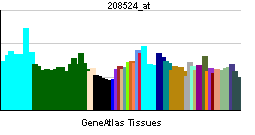GPR15
| G protein-coupled receptor 15 | |||||||||||
|---|---|---|---|---|---|---|---|---|---|---|---|
| Identifiers | |||||||||||
| Symbols | GPR15 ; MGC126828; MGC126830 | ||||||||||
| External IDs | Template:OMIM5 Template:MGI HomoloGene: 3869 | ||||||||||
| |||||||||||
| RNA expression pattern | |||||||||||
 | |||||||||||
| More reference expression data | |||||||||||
| Orthologs | |||||||||||
| Template:GNF Ortholog box | |||||||||||
| Species | Human | Mouse | |||||||||
| Entrez | n/a | n/a | |||||||||
| Ensembl | n/a | n/a | |||||||||
| UniProt | n/a | n/a | |||||||||
| RefSeq (mRNA) | n/a | n/a | |||||||||
| RefSeq (protein) | n/a | n/a | |||||||||
| Location (UCSC) | n/a | n/a | |||||||||
| PubMed search | n/a | n/a | |||||||||
G protein-coupled receptor 15, also known as GPR15, is a human gene.[1]
References
Further reading
- Cunningham AL, Li S, Juarez J; et al. (2000). "The level of HIV infection of macrophages is determined by interaction of viral and host cell genotypes". J. Leukoc. Biol. 68 (3): 311–7. PMID 10985245.
- Heiber M, Marchese A, Nguyen T; et al. (1997). "A novel human gene encoding a G-protein-coupled receptor (GPR15) is located on chromosome 3". Genomics. 32 (3): 462–5. doi:10.1006/geno.1996.0143. PMID 8838812.
- Deng HK, Unutmaz D, KewalRamani VN, Littman DR (1997). "Expression cloning of new receptors used by simian and human immunodeficiency viruses". Nature. 388 (6639): 296–300. doi:10.1038/40894. PMID 9230441.
- Farzan M, Choe H, Martin K; et al. (1997). "Two orphan seven-transmembrane segment receptors which are expressed in CD4-positive cells support simian immunodeficiency virus infection". J. Exp. Med. 186 (3): 405–11. PMID 9236192.
- Clayton F, Kotler DP, Kuwada SK; et al. (2001). "Gp120-induced Bob/GPR15 activation: a possible cause of human immunodeficiency virus enteropathy". Am. J. Pathol. 159 (5): 1933–9. PMID 11696454.
- Strausberg RL, Feingold EA, Grouse LH; et al. (2003). "Generation and initial analysis of more than 15,000 full-length human and mouse cDNA sequences". Proc. Natl. Acad. Sci. U.S.A. 99 (26): 16899–903. doi:10.1073/pnas.242603899. PMID 12477932.
- Croitoru-Lamoury J, Guillemin GJ, Boussin FD; et al. (2003). "Expression of chemokines and their receptors in human and simian astrocytes: evidence for a central role of TNF alpha and IFN gamma in CXCR4 and CCR5 modulation". Glia. 41 (4): 354–70. doi:10.1002/glia.10181. PMID 12555203.
- Maresca M, Mahfoud R, Garmy N; et al. (2003). "The virotoxin model of HIV-1 enteropathy: involvement of GPR15/Bob and galactosylceramide in the cytopathic effects induced by HIV-1 gp120 in the HT-29-D4 intestinal cell line". J. Biomed. Sci. 10 (1): 156–66. doi:10.1159/000068089. PMID 12566994.
- Gerhard DS, Wagner L, Feingold EA; et al. (2004). "The status, quality, and expansion of the NIH full-length cDNA project: the Mammalian Gene Collection (MGC)". Genome Res. 14 (10B): 2121–7. doi:10.1101/gr.2596504. PMID 15489334.
- Blaak H, Boers PH, Gruters RA; et al. (2005). "CCR5, GPR15, and CXCR6 are major coreceptors of human immunodeficiency virus type 2 variants isolated from individuals with and without plasma viremia". J. Virol. 79 (3): 1686–700. doi:10.1128/JVI.79.3.1686-1700.2005. PMID 15650194.
- Cilliers T, Willey S, Sullivan WM; et al. (2005). "Use of alternate coreceptors on primary cells by two HIV-1 isolates". Virology. 339 (1): 136–44. doi:10.1016/j.virol.2005.05.027. PMID 15992849.
| Stub icon | This membrane protein–related article is a stub. You can help Wikipedia by expanding it. |